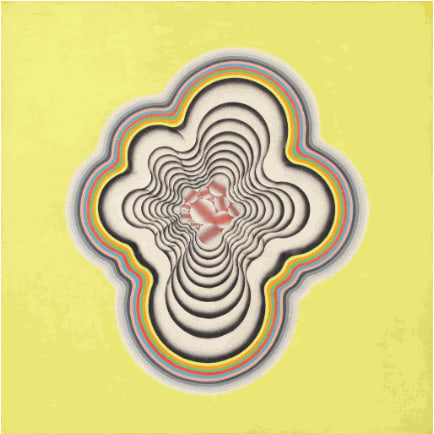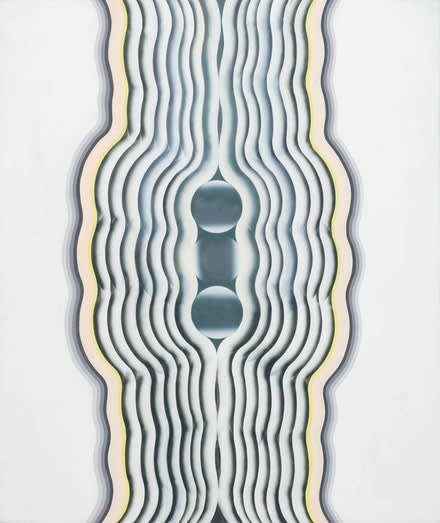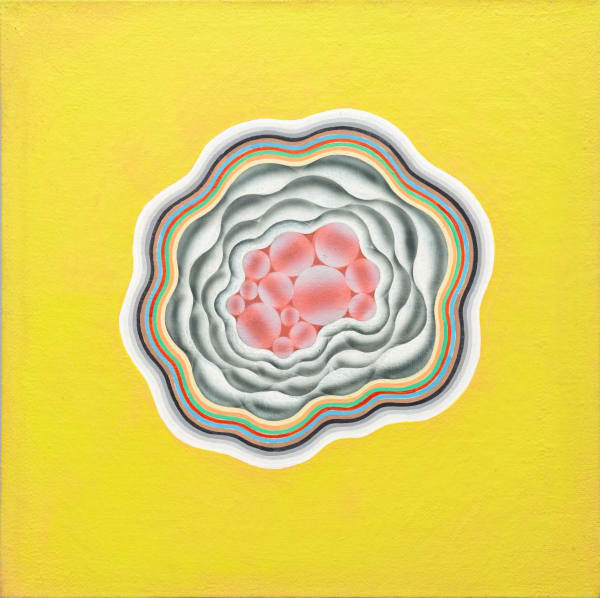Kim Tschang-Yeul: New York to Paris
Tina Kim Gallery is pleased to present its first solo exhibition of Kim Tschang-Yeul (b. 1929), on view from October 24 through December 7, 2019. The exhibition focuses on Kim’s early bodies of work from the late 1960s to early 1980s, surveying the evolution of the artist’s signature painting style when he lived between New York and Paris.
Born in 1929 in Maengsan in North Korea, Kim Tschang-Yeul spent his childhood amid the turmoil of the Korean War and postcolonial liberation. He later fled to South Korea as the North saw a dramatic rise in Communist influence. After studying painting at the Seoul National University, Kim established the Modern Artists’ Association—later renamed as Actuel—in 1958. He joined Korea’s Art Informel movement that same year along with a group of avant-garde artists including renowned Dansaekhwa masters Park Seo-Bo and Chung Sang-Hwa. As one of the first generations of Korean modernist painters, Kim participated in the Paris Biennale in 1961 and the São Paulo Biennale in 1965. These exhibitions opened the door for the artist to embark on his artistic career abroad that would span more than 40 years.
When Kim Tschang-Yeul moved to New York in 1965, Pop Art prevailed as the artistic lifeblood of the city. Following a recommendation by his teacher, Kim Whanki, Kim received a scholarship from the Rockefeller Foundation to study at the Art Students League of New York. During this time, Kim became acquainted with the artist Nam June Paik who later supported Kim’s participation in the Avant-Garde Festival in 1969. It was in New York that Kim began his earliest experiments into painting the bulbous abstract forms that would later lead to his signature style. It was during this time that the artist began experimenting with visceral abstraction, depicting colorful spherical forms which the artist aptly called “paintings of the intestines.”
In 1969, Kim relocated to Paris and began his artistic career anew traveling between France and South Korea, creating a bridge between Europe and his native land. Hosting Dansaekhwa masters such as Lee Ufan, Park Seo-Bo and Chung Sang-Hwa in his St. Germain studio, Kim became a figure of global success to painters back home.
Drawing from the Pop Art and Minimalism he encountered in New York, Kim continued his study of pure abstraction until 1969, at which point he began producing globular, phlegmatic forms that appear to ooze out through the canvas, as in the painting Untitled (1971). The following year, the artist unveiled a painting of a magnified single drop of water in the first exhibition at Salon de Mai in Paris, France. It was Kim’s ability to navigate between diverse modes of abstraction, minimalism, and photorealism that led him to settle into this motif that he would continue to pursue.
Spanning the early 1970s to the present day, Kim Tschang-Yeul devoted his career to a single optical device that allowed him to confront the dichotomy between nature and contemporary culture: the drop of water. As Kim explained, “The act of painting water drops is to dissolve all things within [these], to return to a transparent state of ‘nothingness.’ By returning anger, anxiety, fear, and everything else to ‘emptiness,’ we experience peace and contentment. While some seek the enhancement of ‘ego,’ I aim toward the extinction of the ego and look for the method of expressing it.”
The artist paints the drops themselves with an exactness that leads the viewer to question their own vision or the act of seeing. Their hyperrealism at first glance instills a desire to touch the canvas, tricking the eye in the style of Op-Art. One notes though that the beads find their form not in the depiction of the water, but in their implied surroundings and the optical effects they generate. Kim himself, through his continuous return to water, finds his identity as an artist and an expatriate through his circumstances as the drops find theirs through light and shadow. He explores the complex dualities within a single form: water as a gentle, life-giving element but one that has the power to destroy and erode; the liquid drops having condensed from an invisible gaseous state and destined to return to said state once again as part of an endless cycle, as can be witnessed in Untitled (1973). In an essay on the artist’s work, Lee Ufan noted “it is symbolic to say that in painting water drops Kim does not paint them as an existential phenomenon, but treats them as an event of ‘light.’ […] Perhaps being and non-being are but a directional play of light and shadow.”
In displaying several historic works by Kim Tschang-Yeul, this exhibition at Tina Kim Gallery showcases and traces the artist’s path to settling on the motif that would occupy his entire four-decade-long career. Additionally, it contextualizes the works as self-portraits in which the artist encapsulates and analyses the psychological and emotional consequences of civil war and displacement.
ABOUT KIM TSCHANG-YEUL
Kim Tschang-Yeul was born in Maengsan, Korea in 1929 and graduated from the College of Fine Art, Seoul National University in 1950. In 1996, Kim was bestowed with the French Order of Arts and Letters followed by the National Order of Cultural Merits of Korea in 2012. The artist participated major international group exhibitions such as Korean Contemporary Painting Exhibition, Paris, France (1971); Salon de Mai, Paris, France (1972-76); Korea: Facet of Contemporary Art, Tokyo Central Museum, Tokyo, Japan (1977); and Korean Drawing Now, The Brooklyn Museum, New York, USA (1981). Kim’s significant retrospectives were held at the Gwangju Museum of Art, Korea (2014); National Taiwan Museum of Fine Arts, Taichung, Taiwan (2012); National Museum of China, Beijing (2005); and Jeu de Paume National Gallery, Paris, France (2004). In honor of the artist, Kim Tschang-Yeul Museum was founded in 2016 in Jeju, Korea, recently showcasing Kim’s solo exhibition, Récurrence, in 2018.
His works can be found among the collections of numerous institutions including the National Museum of Contemporary Art, Korea; Leeum, Samsung Museum of Art, Korea; Centre Pompidou, Paris, France, Tokyo Metropolitan Museum of Art, Japan; National Museum of Modern Art, Japan; Hirshhorn Museum and Sculpture Garden, Washington, USA; and Museum of Fine Arts, Boston, USA.
-

What to See Right Now in New York Art Galleries
The New York Times January 15, 2020We are playing historical catch-up at the moment, driven partly by the art market’s incessant quest for fresh products, but also by a widespread desire...Learn More -

Kim Tschang-Yeul: New York to Paris
The Brooklyn Rail December 6, 2019The Korean painter Kim Tschang-Yeul is part of a generation that traveled outside East Asia in the 1960s and ’70s in order to develop a...Learn More -

Kim Tschang-Yeul’s Oozing Guts and Water Droplets are Windows onto Invisible Worlds
Frieze December 4, 2019Visitors to ‘Kim Tschang-Yeul: New York to Paris’, which focuses on the artist’s work from the 1960s to the ’80s, might see any number of...Learn More -

Kim Tschang-Yeul: Art Without Ego
Ocula November 22, 2019Kim Tschang-Yeul turns 90 this December, following an illustrious career that played a crucial role in bringing post-war Korean painting into the modern and contemporary...Learn More -

A Modern Trompe L’Oeil Painter
Hyperallergic November 9, 2019Kim Tschang-Yeul (b. 1929), a towering figure of Korean modern art, is best known for his trompe l’oeil depictions of pristine water drops beaded on...Learn More

